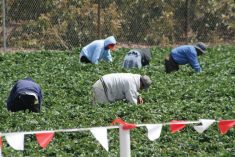As the pandemic grinds on, food banks in Alberta are expecting a sharp rise in people needing help.
They’re already seeing it in Lamont.
The food bank in the town of 1,800 normally assists six to eight people, and their families, a week, said Colette McBride, a volunteer and chair of the County of Lamont Food Bank. When the pandemic first struck, those numbers “really skyrocketed” and then fell below the normal level as government income support flowed through the spring and summer.
“But we’re starting to see a lot of people now,” said McBride. “We’re starting to see a lot of new people that we haven’t seen before and clients that we haven’t seen for a while coming back.
Read Also

Moo translator and methane measures: There’s an app for that
Dalhousie University researchers use artificial intelligence to create new dairy farm apps that analyze cattle sounds and measure methane.
“Now we’re starting to see more in the nine to 15 (people per week) area.”
But some who need help may be staying away out of a fear that food banks might pose a greater risk of contracting COVID-19.
But that’s not the case, says Food Banks Alberta, which recently launched a campaign to tell people that “we are open, safe, and united in welcoming any Albertan in need.”
The impact of the pandemic, the ending of CERB (which is replaced by other programs that may pay less), the troubled Alberta economy, and the rising cost of living are all taking a toll on many people, said the organization, which represents 98 food banks in the province.
Last year, nearly 90,000 Albertans turned to food banks each month, with about 15 per cent relying on rural food banks.

Food banks are expecting to see a rise in numbers as first Christmas and then tax time approaches, said Arianna Scott, the organization’s senior project manager.
“The pandemic has affected many Albertans in different ways,” Scott said in a news release. “These are people who have mortgage and car payments who need to prioritize those payments, but may not be left with much else to be able to put food on the table. Also, with CERB running out, we are also seeing those affected by job loss in industries like energy, tourism and hospitality looking for places to get extra help.”
All sorts of people are facing tough times and that’s evident at the Lamont food bank, said McBride
“It’s a mix (of people),” she said. “At first, we weren’t sure what demographic was going to have the most increase. It seems to be everybody who needs help.”
Not only has COVID kept some people from seeking assistance at food banks, it’s also kept away some donors — and part of the provincial campaign is to let them know that it’s safe to donate.
Just like retail operations, the County of Lamont Food Bank has revamped its practices. Clients used to be able to drop by, come in, get interviewed and then pick items they would need.
Now everyone must make an appointment, and wear a mask and use hand sanitizer. The intake person who sees clients is behind a Plexiglas barrier and pre-packaged hampers are wheeled to the person’s vehicle on a cart (which is sanitized afterwards).
McBride said support for the Lamont food bank has been steady this year, but more donations will likely be needed.
“We’re coming up on a time of year when we would normally get a lot of donations,” she said. “We’re not sure how that’s going to work. We used to get a lot of donations through the schools, but kids aren’t allowed to take things to school.”
Another big source of donations was the “stuff the bus” event held as part of the Lamont Christmas Light Up each year. The food bank won’t be doing that this year, but hasn’t come up with an alternative yet.
“That’s the stuff we’re grappling with now,” said McBride. “I want to make sure people have the opportunity to donate. For some people, it’s something that happens at Christmastime; they always donate.”
The Lamont food bank’s Facebook page has a lot of followers and its volunteers post what’s needed on a weekly basis. People put donations in bins around the county, and seem to tailor them to the requests, said McBride.
Anyone who wants to donate to a food bank can check foodbanksalberta.ca, which has a list (under the Resources tab) of what to donate (it includes toilet paper, diapers and feminine hygiene items).
It also has a list of food banks across the province and their hours (or a contact number).
People who need help shouldn’t hesitate to contact a food bank in their area, said McBride.
“There’s no shame in accessing the food bank. That’s why we’re here — to help people,” she said.
“Sometimes you have to use the food bank so you don’t get behind on your food. If you don’t eat, your health suffers.”
















